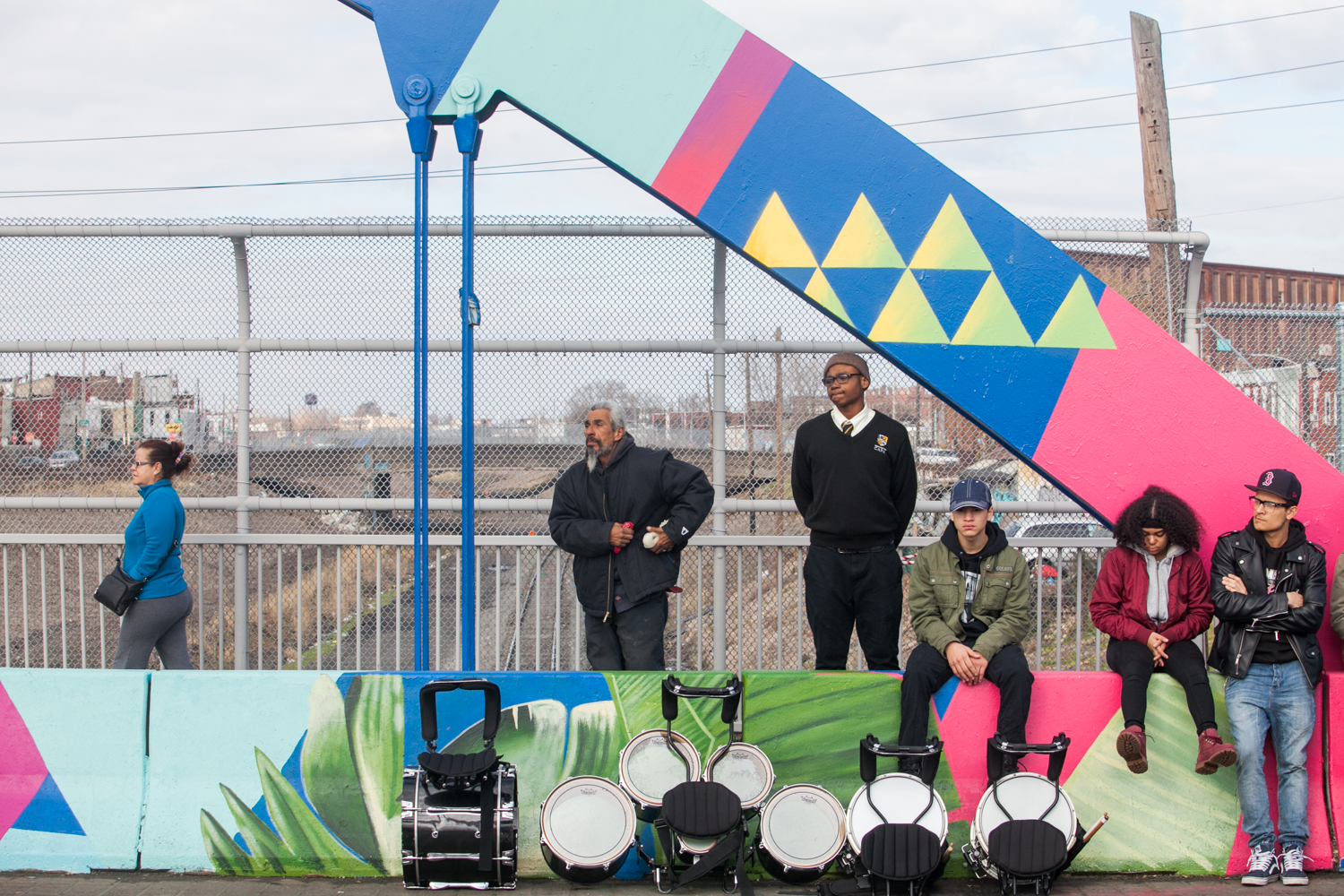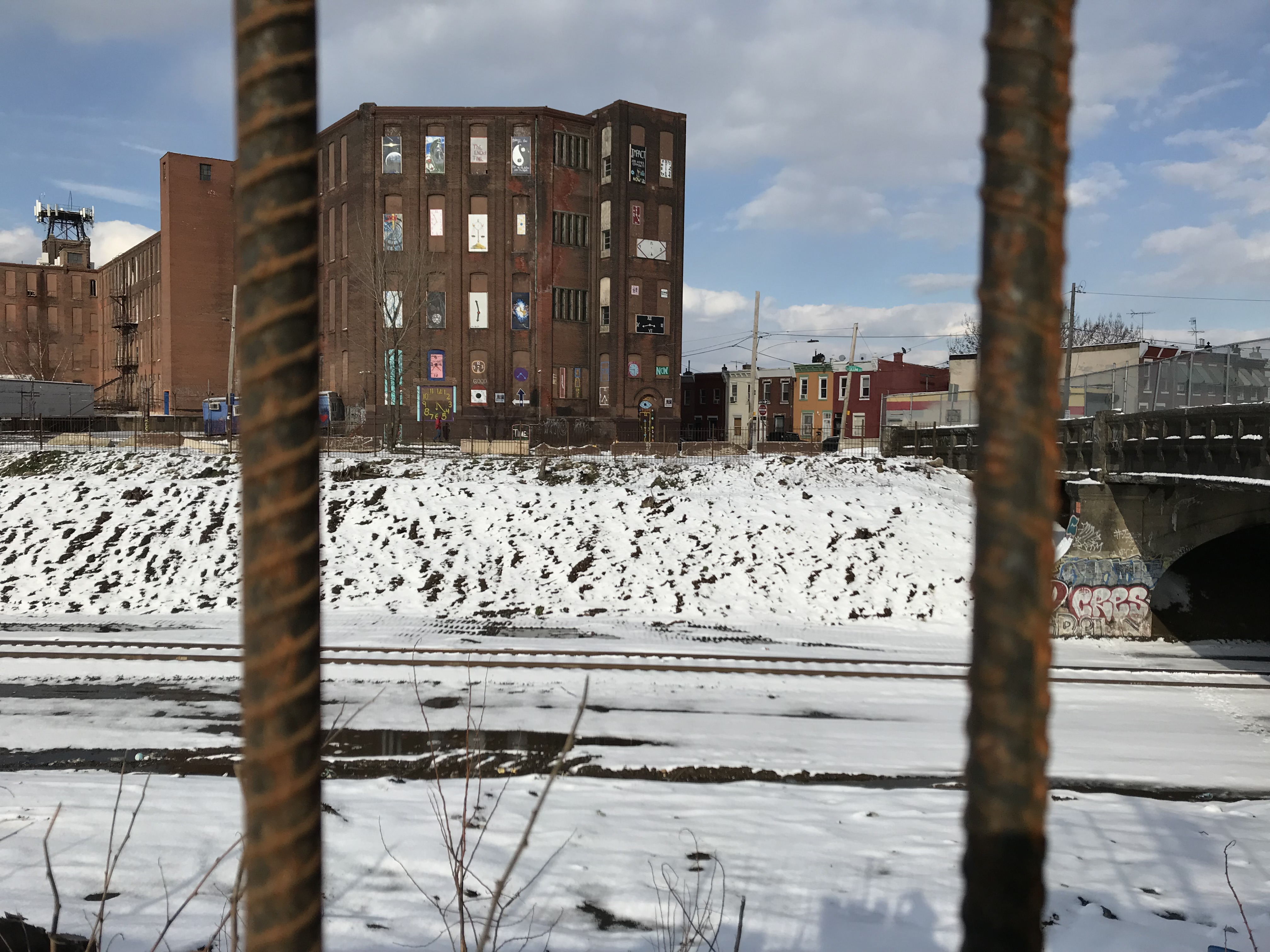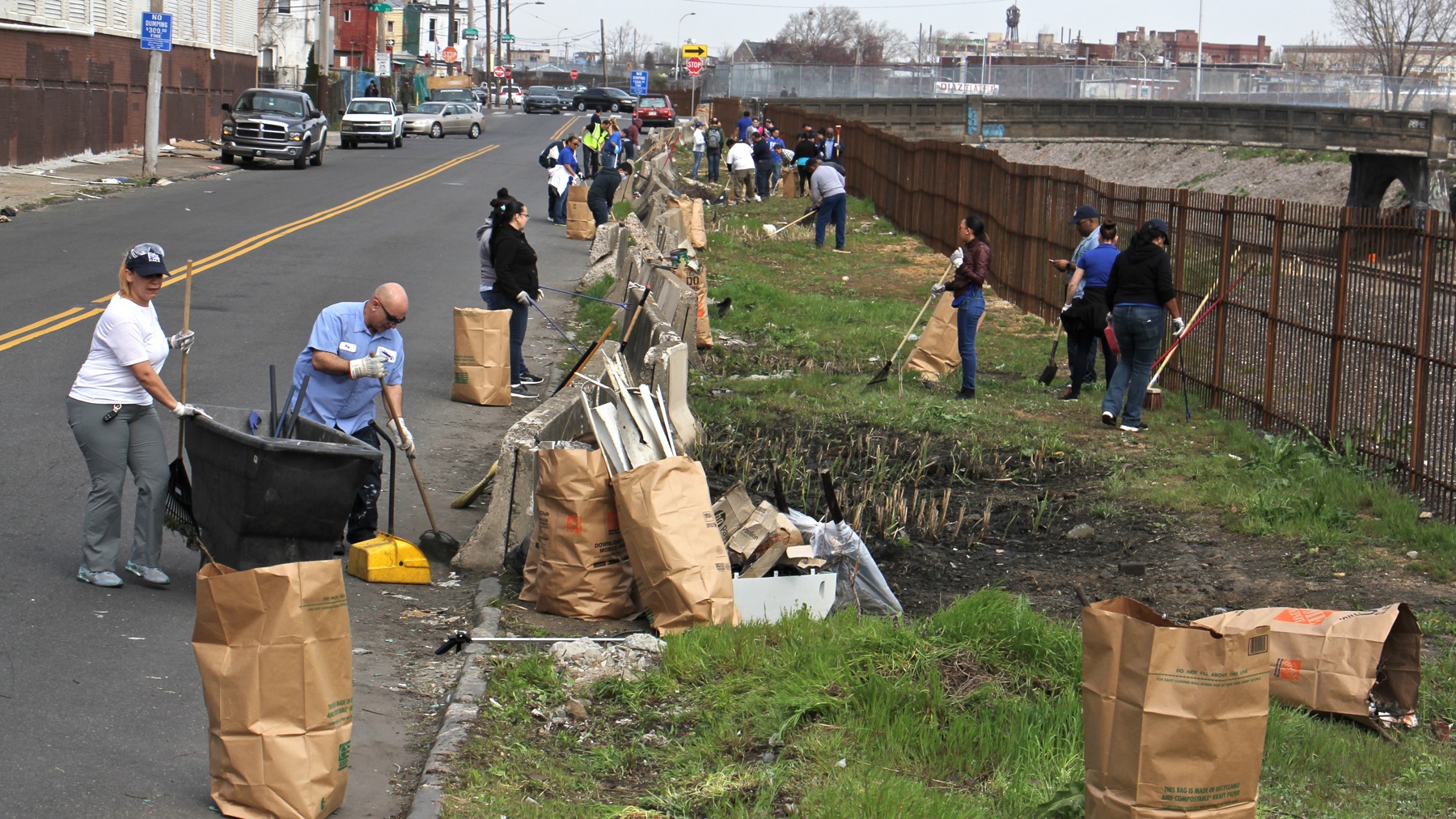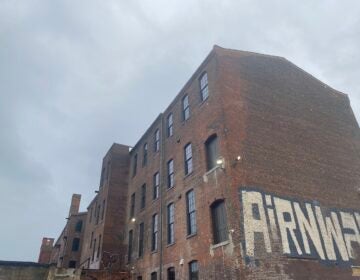Can better urban design help Philadelphia fight the opioid crisis?
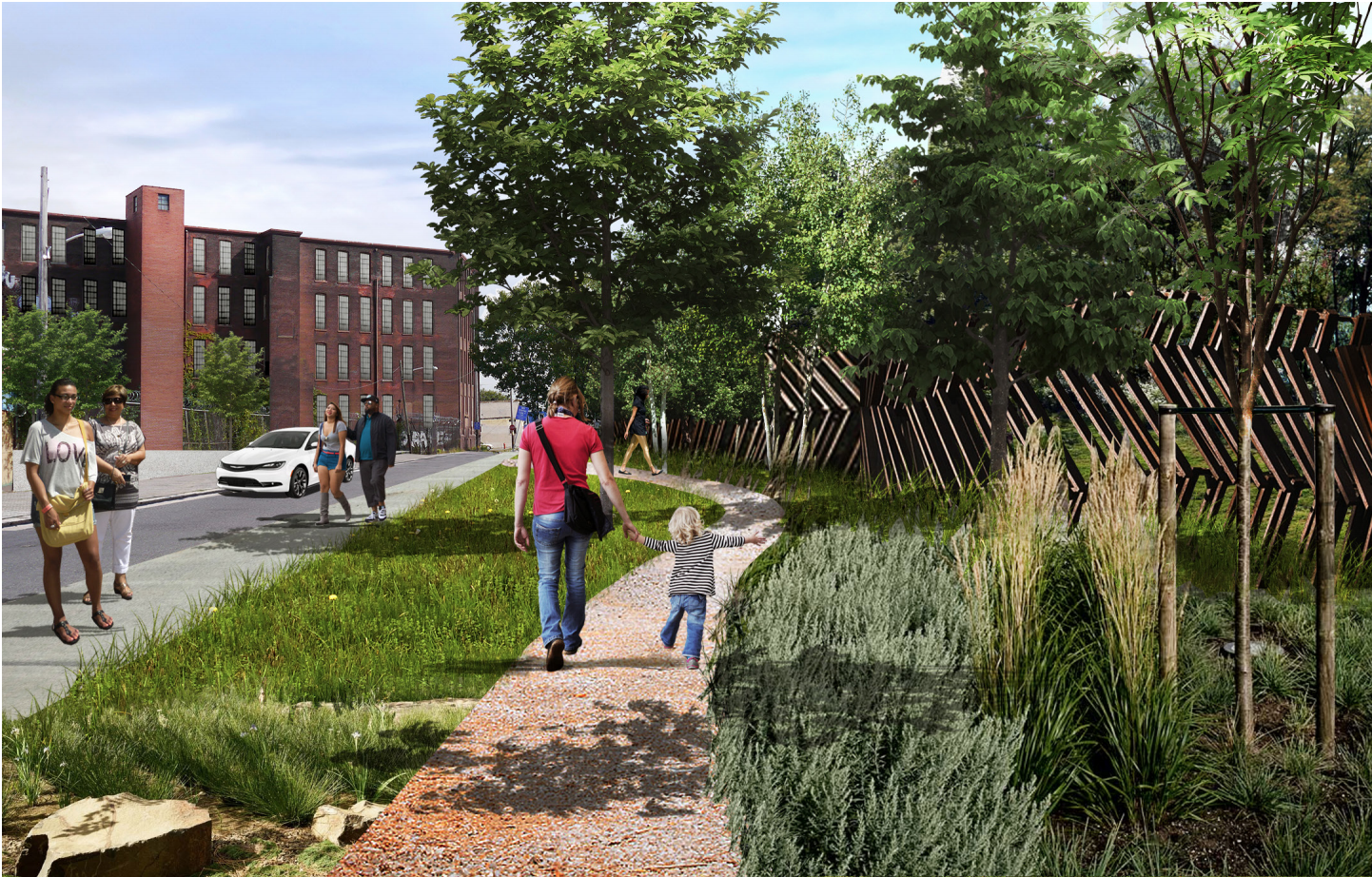
A bright mural of cartoonish clocks and playful meditations on time cover a boarded-up former textile mill at the edge of the Conrail tracks in Kensington.
Just down the street, a bridge painted in technicolor hues crosses the litter-strewn tracks at B and Tusculum Streets. Painted by Calo Rosa, a Philadelphia artist with roots in El Salvador, and a crew of young adults working with Mural Arts Philadelphia, the bold blue and pink graphics are meant to evoke the Latin American heritage of the surrounding community — and a better future for an area that for too long served as ground zero of the city’s opioid crisis.
The murals aren’t the only thing that has changed in this corner of North Philadelphia. After lengthy negotiations between City Hall and Conrail, the railroad operator began a multi-million dollar clean up of the area last summer. Working together with city partners, they removed tons of illegally-dumped junk, razed an encampment that had become an open-air shooting gallery and cleared dense vegetation that had provided a green cover for drug users and their dealers.
Now the once-overgrown gulch resembles a desert valley, secured by new fencing and exposed to neighbors.
But that doesn’t mean the problems are solved.
“The [Conrail] line has been cleaned before and it has reverted back to what it used to be,” says Maria Gonzalez, executive director of the Hispanic Association of Contractors and Enterprises (HACE), a community development corporation in the surrounding neighborhoods of Fairhill and West Kensington.
HACE provided funding for the B Street Bridge makeover. Gonzalez says it was a symbol to assure residents that this time, real change was coming to the community.
“Here’s the first project–more is coming,” she says.
Next up: transforming the vacant land alongside the Conrail tracks into a landscaped greenway decorated with new public art installations.
Earlier this month, HACE broke ground on the new path, which will initially stretch between the A Street to B Street bridges over the tracks. HACE owns a gated senior living facility at one end of the pending walkway
“My seniors have been trapped in that little campus,” Gonzalez says. “When they leave, they’ve been assaulted many, many times.”
Another community partner, Impact Services Corporation, will work to maintain property on the other side of the tracks. The nonprofit wants to continue the greenway on a block of open space across the street from the A Street textile mill, which is part of a complex it owns.
Final plans depend on community input, but the design concept calls for a paved path for walking or running that winds around gardens, trees, and public art. The greenway would cross over the tracks on the A Street bridge connect with HACE’s trail on the other side.
To fund their work, Conrail is providing HACE and Impact Services a combined $1.25 million over six years to put toward community development efforts around the tracks. The money, coming indirectly from the state via corporate tax credits offered by the Pennsylvania Department of Community and Economic Development, will support the organizations as they test a relatively new strategy for preventing crime in an area: making it a more attractive place to be.
The idea is that by turning neglected spaces into livelier places where people want to go, drug users will no longer feel free to go about their business there.
“If people in the area use it, it’s less likely to be taken over by the bad stuff,” Gonzalez explains.
It’s a theory that is guiding larger neighborhood plans that HACE and Impact Services are working to develop with others in the community. These plans intend to connect infrastructure improvements to intangible assets such as social connectivity and community strength.
After all, no one single thing caused the opioid crisis and no one thing will cure it.
“I think it’s dangerous to think [that cleaning up the tracks is the whole solution] because it is not solving the problem, it’s just moving it,” says Impact Services community development director Patricia Codina.
Indeed, since Conrail cleaned the tracks last summer, new encampments of drug users have formed less than a mile away. In an ironic turn of events, these encampments have settled into infrastructure for the very same railroad tracks, in tunnels running under a viaduct farther east down the line.
Learning from Methadone Mile
Codina, Gonzalez and their partners in Kensington aren’t the only people experimenting with urban design as a tool to fight the opioid crisis. A few hundred miles up the Northeast corridor at the edge of Boston’s South End, city officials are working with a team of architects and healthcare professionals to redesign infrastructure in a part of the city that, like the Conrail tracks, has become a hotspot for people looking to get high. An unwelcoming concrete canyon where Interstate 93 meets the parking lots and brick highrises of Boston Medical Center and a cluster of homeless shelters and addiction clinics, “Methadone Mile” is how locals refer to the intersection of Massachusetts Avenue and Melnea Cass Boulevard.
In 2016, Mayor Marty Walsh convened a working group in 2016 that aimed to address the problems ailing the area and rebrand it as “Recovery Road.” That same year, architects with MASS Design Group began to think about how the built environment could better serve people in the area. The Boston-based nonprofit’s plan, which was presented to the working group last summer, would create welcoming plazas and courtyards within the now barren medical campus. The designers imagine filling them with murals, new light fixtures, benches, and even food trucks. Patricia Gruits, a MASS architect who worked on the plan, says that their goal is to ensure that as these new amenities attract more of the general public, they remain accessible to those who go there for treatment and services. In addition to the clinics and homeless shelters in the area, there is a needle exchange, and even a come-down spot where people can be monitored for signs of overdose while they’re under the influence. Between all of these service centers, there are very few safe, hospitable places for people to gather, she says. “There is very limited outdoor space–maybe a picnic table or two–actually allocated to those programs,” says Gruits. That’s led to overcrowded streets and sidewalks, contributing to a sense of public disorder. The new plazas or courtyards could also help engage people passing by, who might be interested in getting help but not yet connected to the area’s facilities.
“They can then see the different services that are being provided, know it exists for them, potentially have access to very simple washrooms, needle disposal, trash bins, benches, places to sit that are appropriate and specifically designed in cooperation with these facilities,” Gruits says.
The designers were “looking for ways in which infrastructure can create a dignified experience–to encourage people on the road to recovery, not to have it be something that is stigmatized,” the architect says.
New amenities for drug users: a tough sell
In Kensington, public health professionals and many community advocates see engaging drug users to coax them into accepting treatment and housing services as part of a strategy to rediuce the number of people living and dying on neighborhood streets. But to many residents, the idea of building new facilities for those battling addiction provokes suspicion, if not outright hostility. Kensington residents have lived in the shadow of the opioid crisis for years and tend to feel that the city willfully neglected a problem that was concentrated in an impoverished, largely Hispanic community.
Laura Ahramjian is a senior planner for KSK Architects Planners Historians, Inc., a Philadelphia firm that worked with HACE to create its neighborhood plan. Ahramjian says that during the organization’s community engagement process, residents expressed concerns that adding or enhancing drug treatment services would attract more users to the neighborhood and continue to concentrate the problem there.
“Because of that pushback, it wasn’t something that we really took into account in the plan,” Ahramjian says. As a result, the pairing of new infrastructure and recovery services featured in MASS’s vision for Boston doesn’t appear in HACE’s plan for Kensington.
Similar community resistance has played prominently into the debate over Philadelphia’s support for a safe injection site, and complicated the city’s efforts to open new homeless shelters for people in active addiction.
Even so, the neighborhood plans crafted by both HACE and Impact Services emphasize coordinating with the city to provide services and bring more users into treatment and recovery. HACE’s Gonzalez says the organization is working with the city on developing a possible site for a new shelter. Both organizations say they are following the city’s lead as it implements the recommendations of Mayor Kenney’s task force on the opioid crisis.
“We recognize that the solution to these problems is really not at the community level,” Codina says.
A test run for one Kensington block
Even if new connecting new public spaces to recovery and treatment programs in Kensington hasn’t figured into a wider neighborhood infrastructure plan, there is at least one service hub with plans to implement the concept on a smaller scale. Prevention Point Philadelphia operates the city’s only syringe exchange program, a health clinic that provides addiction treatment, and the neighborhood’s only shelter for homeless drug users. The organization runs out of an old church on the corner of Kensington Avenue and Monmouth Street.
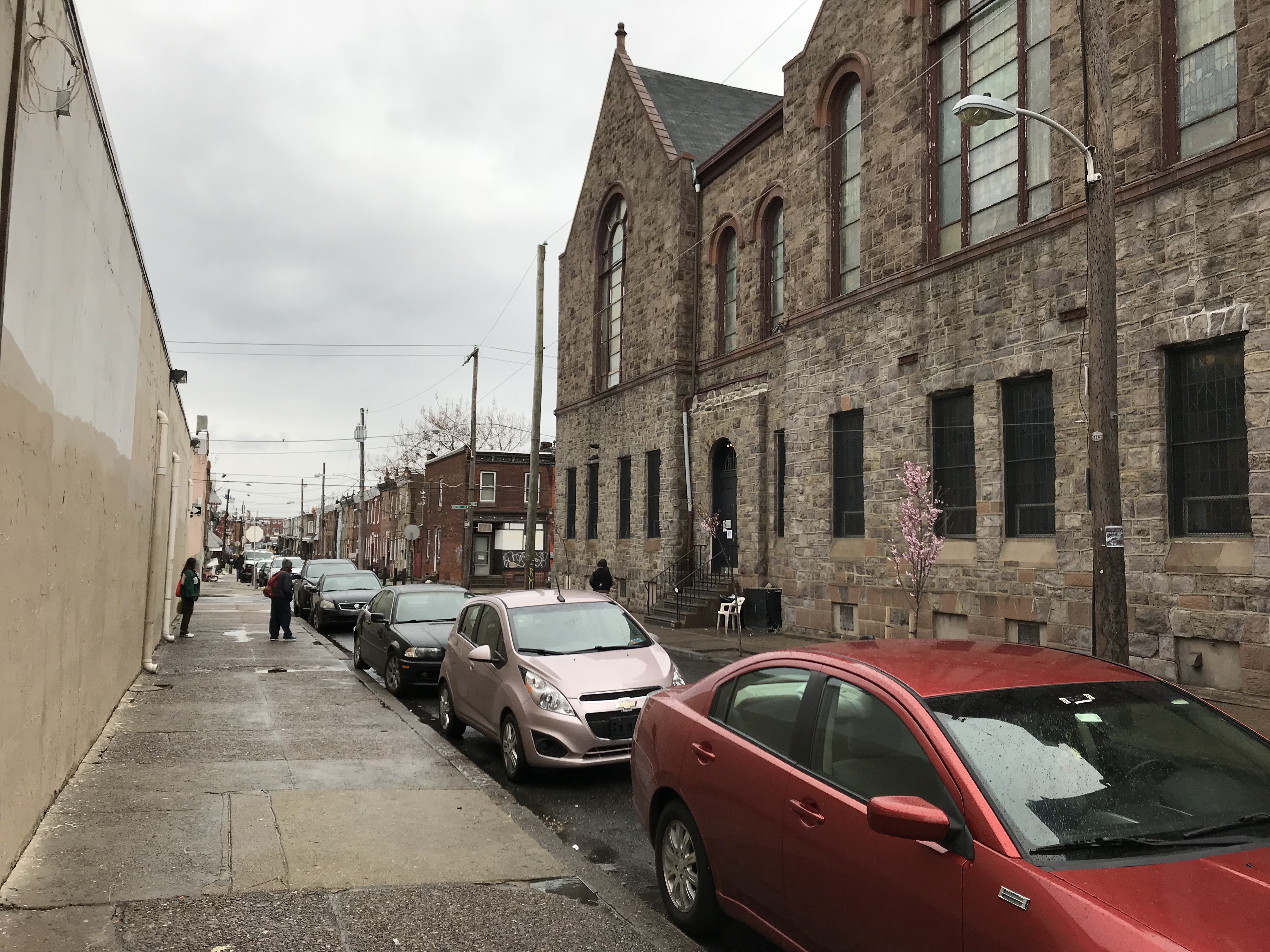
Last December, Prevention Point opened a 40-bed shelter in a building across the street on Monmouth Street, making it the sole tenant of the small block. The expansion provides Prevention Point an opportunity to give the block a “campus feel,” says executive director Jose Benitez. Prevention Point has plans to transform what is now a bleak stretch of empty sidewalk and blank walls into a comfortable, welcoming public space where people can spend time and hopefully, connect to service providers.
The first step, expected to roll out this spring, is new lighting strung over over the street between buildings. Benitez hopes that tables, chairs and street trees will follow the new lights.
The Mural Arts Program is planning a mural for the shelter’s exterior.
Benitez, like Gruits in Boston, sees the improvements as a way to reduce the stigma attached to addiction treatment.
Before Prevention Point moved into its current location, the facility didn’t even have a sign, Benitez says, preferring to avoid notice from neighbors who might not support their work. But after moving to the new building, he felt compelled to show that the organization wasn’t ashamed to announce its presence.
“I was like, you know what, we have to start figuring out some of the stigma around this issue,” Benitez says. “And if that means we have a big sign that says ‘Prevention Point’ on it, then that’s what it means.”
WHYY is your source for fact-based, in-depth journalism and information. As a nonprofit organization, we rely on financial support from readers like you. Please give today.



